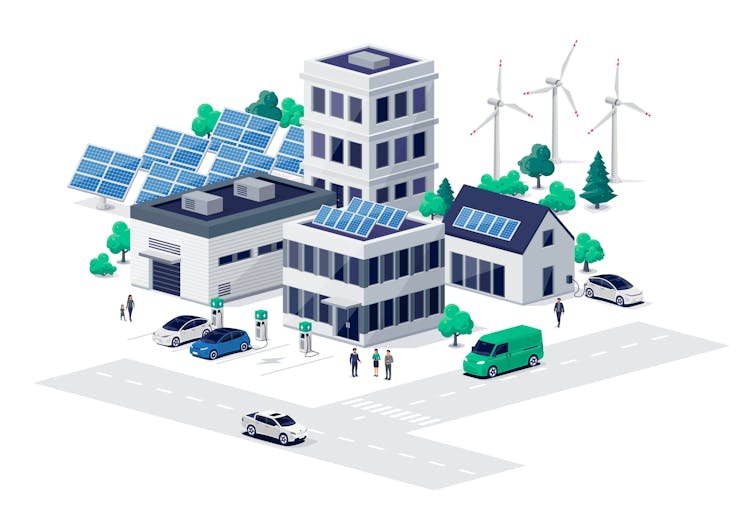To support its climate agenda, the Albanese government is building new institutions. One of the most important will be the Net Zero Economy Authority. The proposed laws to create this authority are currently before the Senate.
Institutions like this can prove enduring despite Australia’s contested climate politics. While the carbon price introduced in 2012 was repealed, the climate and renewables institutions the Rudd/Gillard Labor governments created continue to this day.
You might ask why we need another one. It’s because getting to net zero is a very big job, as new low-emissions industries come online while high-emissions industries exit. This authority would take the lead on aligning policies between different tiers of government, facilitating investment, helping fossil fuel workers transition to new jobs, and communication.
What should it look like? We reviewed international best practice in a newly released report for the authority’s predecessor, the Net Zero Economy Agency. Our recent submission suggests Australia’s authority should identify green investment options and co-ordinate, but should not invest itself. It should focus on finding and evaluating new green industrial options. And it should focus not just on helping coal workers change careers, but on the surrounding communities as well.

The authority should look for green investments but not invest directly
We already have a rich landscape of green investment support, including the Clean Energy Finance Corporation, Australian Renewable Energy Agency, the National Reconstruction Fund, and the Powering the Regions Fund, as well as the new Future Made in Australia agenda, and direct government grants and tax credits.
There is no need for another funding body.
What the authority can do here is provide insights and a coordination role, using sound investment principles such as cost effectiveness and assessing the likelihood of future financial and economic returns to governments and society.
It could help policymakers prioritise actions amid a complex mix of policy objectives, such as low-emissions systems, supply-chain security, jobs, regional development, benefits to First Nations communities, and social equity.
Find and scrutinise new industrial opportunities
Governments globally are turning to green industrial policies to support jobs and growth as well as to decarbonise. The United States, the European Union, and Japan are using green stimulus in the race with China, which dominates many renewable industries.
As a mid-sized economy, Australia cannot compete in every sector and segment of the value chains likely to thrive through the energy transition. We have to choose.
That’s where the Net Zero Economic Authority comes in. We need a lead agency to coordinate industry strategies, including identifying Australia’s competitive advantages across global value chains.
Green industry policies should be understood as a process of discovery and problem solving, not just handing out subsidies.
Focus on fossil fuel communities
Many communities have grown up around fossil fuel power stations and industries, including towns in Gippsland in Victoria, the Hunter Valley in New South Wales and the gas export hub of Gladstone in Queensland.
To do its job well, the authority should not be limited to helping workers directly affected by the closure of coal power stations, as the bill indicates.
Just under 20% of coal mined in Australia is burned here for electricity generation. Almost 50% is exported for coal plants overseas, and metallurgical coal exports for steel-making make up the remainder. In the global transition to net zero, demand for both thermal and metallurgical coal will fall, and with it, Australian export income.
At present, the Net Zero Economy Authority Bill relies on planned closures of domestic power stations as the trigger to provide worker transition support via legislated processes. The scope is limited to workers in coal and gas power stations and dependent employers such as supplying coal mines – excluding the vast majority of Australia’s coal workers. It is difficult to see the rationale for this.
It would be better if the authority’s legislated remit included a strong focus on regional prosperity in the transition. That’s because shutting down a major mine has wider effects, including to contractors and regional small businesses. The authority has a sizeable budget allocation for its support functions, which could be used more widely toward broader regional prosperity.
Extending support out beyond just the affected workers is something we should have learned from the painful shutdown of Australia’s car manufacturing industry.

Learning, participation, monitoring and reporting
Many other nations have moved to create new institutions to usher in the new economy, for instance Germany’s Coal Commission, Canada’s Just Transition for Canadian Coal Power Workers and Communities, and South Africa’s Presidential Climate Commission. We don’t have to reinvent the wheel – we can draw on international experience.
For Australia’s authority to be effective, it will have to excel in policy coordination. Often, state and federal policies may not align directly – or may even pull in different directions.
For instance, it could play a vital role in coordinating the efforts of NSW’s authority overseeing renewable energy zones, EnergyCo, and the federal green manufacturing and mining agenda, Future Made in Australia. Let’s say you wanted to make green hydrogen. It makes sense to locate federally backed hydrogen plants next to big state-run renewable zones.
Change can be confronting – especially when communities feel it is being imposed on them. To avoid this, the authority must make community participation a central part of its efforts, especially in the regions set to house many of our new green industries and power sources.
The final role for the Net Zero Economic Authority could be to monitor, report and evaluate progress. This is essential, given the size of the transition. It can help governments, business and the community understand whether policy interventions are working or if it’s time to rethink.
Transparency about successes and failures of transition will be essential to build and maintain public trust during a time of fundamental change in parts of Australia’s economy.
Correction: This article has been amended to clarify the distinction between the NZEA’s legislated requirements and its broader functions, and to define more precisely the range of employers who will be affected.

